©Damen,
2021
Classical Drama
and Theatre
Return to Chapters
SECTION 2: CLASSICAL GREEK TRAGEDY AND THEATRE
Chapter 6: Early Classical Theatre
I. Introduction: An Overview of Classical Greek Drama
Let's begin by overviewing what we'll cover in the next two sections of the
class: Classical Greek Tragedy (Section 2) and Greek Comedy (Section 3).
According to Aristotle, the Athenians developed tragedy first, with comedy
following a generation or so later. While this assessment is essentially correct,
the truth seems to have been somewhat more complicated. Comic dramas as opposed
to comedy itself—that is, humorous performance pieces versus the formal genre of "comedy"—appear
to have evolved alongside their tragic counterpart, perhaps even before it.
The satyr play, in particular, which consisted of a farcical rendition of myths more often treated
seriously and featured a chorus of rowdy, irreverent satyrs (half-human half-animal
spirits of the wilderness notorious for their lust and gluttony), emerged early
in the tradition of Greek theatre, though exactly how early is not clear. Nevertheless,
the historical sources for theatrical performances in the Classical Age focus
largely on tragedy as the hub of early dramatic activity, even if its pre-eminence
probably looks clearer in hindsight than it may have seemed in the day.
 Three
tragedians emerge from the fifth century BCE as the principal practitioners
of classical Greek tragic drama: Aeschylus, Sophocles, and Euripides. Theirs
are the only tragedies preserved whole. First and foremost, Aeschylus lived
a generation earlier than the other two so his work provides our first hard
look at Greek drama. Even if his plays may seem static and slow-moving to modern viewers, there can be little doubt they were exciting, novel and controversial in their day.
Three
tragedians emerge from the fifth century BCE as the principal practitioners
of classical Greek tragic drama: Aeschylus, Sophocles, and Euripides. Theirs
are the only tragedies preserved whole. First and foremost, Aeschylus lived
a generation earlier than the other two so his work provides our first hard
look at Greek drama. Even if his plays may seem static and slow-moving to modern viewers, there can be little doubt they were exciting, novel and controversial in their day.
The elder of the later pair, Sophocles is often seen as the best playwright
of the three—in the general estimation of many in the scholarly community,
Sophocles remains the finest exponent of tragic arts ever—and certainly
his polished dramas were very well-respected in the Classical Age, as they have
been for the most part ever since. It is somewhat ironic to note, then, that
interest in his drama in performance seems to have waned soon after his
lifetime.
Conversely, Euripides, while alienating his contemporaries and considered by
many a distant second to Sophocles when the two of them were alive, left behind
a body of drama that commanded the stage after the Classical Age. There can
be little doubt why: Euripides had a knack for putting on stage eye-catching
situations and creating memorable characters with extreme personality disorders.
Accordingly, theatrical records show that his works were very frequently produced
in later ages, outstripping both the popularity of Sophocles and Aeschylus.
No Greek tragedy from the fourth century or later (the Post-Classical Age)
has been preserved intact, making it hard to determine the course of tragic
drama in Greece after the lifetime of Sophocles and Euripides (note).
We can, however, follow the evolution of its close kin, comedy, in later Greek
theatre.
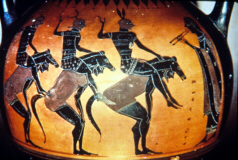 The
presentation of humorous material has deep roots in ancient Greece and is perhaps
as old as tragedy itself, but because comedy was seen as a lesser art form until
quite late in the evolution of Western Civilization, the evidence for this genre
of drama is scant. Historical records make it clear that skits designed to provoke
laughter were being written throughout and even before the Classical Age—comedy
officially premiered at the Dionysia at some point during the 480's BCE, between
the Persian Wars—and this type of theatre, now termed "Old Comedy,"
gained popularity steadily across the fifth century. In particular, it began
to attract widespread attention during the Peloponnesian War when productions
of comedy provided the Athenians much needed relief from the anxiety and hardships incurred during their conflict against Sparta.
The
presentation of humorous material has deep roots in ancient Greece and is perhaps
as old as tragedy itself, but because comedy was seen as a lesser art form until
quite late in the evolution of Western Civilization, the evidence for this genre
of drama is scant. Historical records make it clear that skits designed to provoke
laughter were being written throughout and even before the Classical Age—comedy
officially premiered at the Dionysia at some point during the 480's BCE, between
the Persian Wars—and this type of theatre, now termed "Old Comedy,"
gained popularity steadily across the fifth century. In particular, it began
to attract widespread attention during the Peloponnesian War when productions
of comedy provided the Athenians much needed relief from the anxiety and hardships incurred during their conflict against Sparta.
While the names of several exponents of this genre in the fifth century are
preserved, and in some cases fragments of their work as well, the plays of only
one Old Comedy playwright, Aristophanes, have come down to us complete. His
drama—and presumably that of his predecessors and contemporaries, too—was
primarily built around current events and issues. Indeed, all indications point
to political and social satire as the hallmark of Old Comedy, especially toward
the end of the Classical Age.
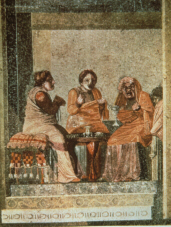 After the end of the Peloponnesian War, as Greece moved into the post-classical
period, comedy underwent a major transformation. Toward the end of the fourth century (the 300's BCE), comic drama shifted from ridiculing celebrities
and the regime in power into a new and very different-looking type of entertainment that focused on the lives and lifestyles of less prominent people. Out of the
ashes of civil war and Alexander's conquests and fueled by the desperation of the
upper-middle class was born the "sit-com."
After the end of the Peloponnesian War, as Greece moved into the post-classical
period, comedy underwent a major transformation. Toward the end of the fourth century (the 300's BCE), comic drama shifted from ridiculing celebrities
and the regime in power into a new and very different-looking type of entertainment that focused on the lives and lifestyles of less prominent people. Out of the
ashes of civil war and Alexander's conquests and fueled by the desperation of the
upper-middle class was born the "sit-com."
The master of this "New Comedy" was Menander, heralded by at least
one ancient critic as an author unsurpassed in quality. However, for reasons
having nothing to do with his brilliant stagecraft, his work did not survive
the Middle Ages. Fortunately, the sands of Egypt have rendered up several of
his plays, albeit in "rags and patches" but well enough preserved
for us to see what his drama looked like. Character-driven, highly stylized with a slate of recurring characters, and more inclined toward subtle rather than broad
humor, Menandrean New Comedy marks the beginning of modern
drama.
II. Theatron
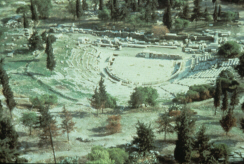 The
physical remains of Greek theatre from the Classical Age are pitifully few,
making it a treacherous enterprise to reconstruct the theatre spaces, sets,
costumes, music or any of the material features of theatre deployed during the great age
which fostered Greek tragedy (the 400's BCE). Thus, what is known about theatre
in the century before that, the 500's BCE, the age when drama itself first emerged,
is a veritable blank. Most Greek theatres visible today around the Mediterranean
basin were constructed after the Classical Age, while those few which belong
to the earliest periods of theatre evolution have almost universally been renovated
in later periods of antiquity, leaving them dubious sources of information about
classical theatre. That is, they constitute "secondary sources," for
the most part.
The
physical remains of Greek theatre from the Classical Age are pitifully few,
making it a treacherous enterprise to reconstruct the theatre spaces, sets,
costumes, music or any of the material features of theatre deployed during the great age
which fostered Greek tragedy (the 400's BCE). Thus, what is known about theatre
in the century before that, the 500's BCE, the age when drama itself first emerged,
is a veritable blank. Most Greek theatres visible today around the Mediterranean
basin were constructed after the Classical Age, while those few which belong
to the earliest periods of theatre evolution have almost universally been renovated
in later periods of antiquity, leaving them dubious sources of information about
classical theatre. That is, they constitute "secondary sources," for
the most part.
Our data concerning classical stage practices, such as acting styles, costumes,
musical accompaniment and the like, tend to be equally unclear. Though some
historical sources seem to provide reliable information about the performance
of classical tragedy, the modern appreciation of these data still relies heavily
on the fifth-century dramas that happen to have survived. To make matters worse,
ancient theatre was in its customs and practices a rather fluid enterprise,
and what rules applied to one period—or even one decade!—may not
necessarily have applied to another. As a consequence, the discussion below
is an attempt to review the highlights of an issue clouded in mystery and focus on a few of the better attested theatre practices of the classical and post-classical
period.
A. Festivals and the Nature of Ancient Performance
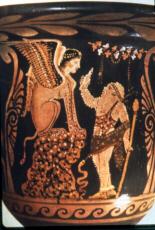 For
some time—at least until the middle of the fifth century (ca. 450
BCE)—all Greek drama appears to have been presented at the City Dionysia,
the annual Athenian festival held each
spring in honor of the god Dionysus. While it's clear this celebration featured a competition
among dramatists in which works were awarded first-place, second-place and third-place prizes, much else is uncertain, such as the number of tragedians invited to participate each year, how many plays individuals presented and how many days the festival took. The rules seem
to have changed over the course of the century. That tragedies would later be
packaged into trilogies—groups of three plays
connected by plot or theme, or both—with a comic satyr play
appended afterwards, has led some scholars to retroject this tradition back to
the earliest days, but the validity of that supposition is impossible to determine
given the paucity of information within our grasp.
For
some time—at least until the middle of the fifth century (ca. 450
BCE)—all Greek drama appears to have been presented at the City Dionysia,
the annual Athenian festival held each
spring in honor of the god Dionysus. While it's clear this celebration featured a competition
among dramatists in which works were awarded first-place, second-place and third-place prizes, much else is uncertain, such as the number of tragedians invited to participate each year, how many plays individuals presented and how many days the festival took. The rules seem
to have changed over the course of the century. That tragedies would later be
packaged into trilogies—groups of three plays
connected by plot or theme, or both—with a comic satyr play
appended afterwards, has led some scholars to retroject this tradition back to
the earliest days, but the validity of that supposition is impossible to determine
given the paucity of information within our grasp.
What is clear is that among the ancient Athenians interest in theatre
as an art form rose precipitously from the end of the Pre-Classical Age (ca.
500 BCE) and continued to grow steadily over the course of the fifth century.
For instance, in the 440's BCE another competition among tragic and comic dramatists
was instituted at a subsidiary festival held in honor of Dionysus, the Lenaea,
a strictly intra-Athenian affair occurring in mid-winter (late January). By
the post-classical period (after 400 BCE), all sorts of festivals had started
to incorporate drama into their festivities whether they had a natural connection
with theatre or not. Clearly, the popularity of theatre made it attractive to
a wide range of cults as a way of catering to the public. It comes as no surprise,
then, that Greek plays began in this age to be exported all over the ancient
world, laying the foundation for not only theatre as a key feature of ancient
Western Civilization but also Greek as the "common" (koine)
language of international commerce in this region.
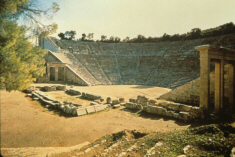 The
performance spaces of classical antiquity are enormous by today's standards,
closer in size to modern sports stadiums than the sorts of theatres with which
we are most familiar. Outdoors and most often situated on steep slopes that
curve around the playing area, many ancient theatres were capable of housing
thousands of spectators. These theatra (the plural
of theatron) call for a certain style of performance. In order to be heard, for
instance, ancient actors had to have a strong voice. Likewise,
costumes, sets and movement also needed to be visible from and intelligible
at some distance. Unlike modern realistic plays which for the most part call
for intimate, indoor theatre spaces with controlled lighting, ancient drama
had more the feel we associate with large-scale athletic events.
The
performance spaces of classical antiquity are enormous by today's standards,
closer in size to modern sports stadiums than the sorts of theatres with which
we are most familiar. Outdoors and most often situated on steep slopes that
curve around the playing area, many ancient theatres were capable of housing
thousands of spectators. These theatra (the plural
of theatron) call for a certain style of performance. In order to be heard, for
instance, ancient actors had to have a strong voice. Likewise,
costumes, sets and movement also needed to be visible from and intelligible
at some distance. Unlike modern realistic plays which for the most part call
for intimate, indoor theatre spaces with controlled lighting, ancient drama
had more the feel we associate with large-scale athletic events.
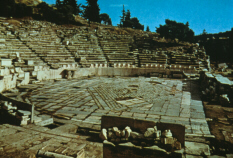 Actually,
if the ancient Greeks had compared drama to anything in their day, it would
probably have been courtroom trials. Lawyers back then were
seen as "actors" of a sort inasmuch as they provided some of the more
sensational and theatrical moments in Greek history. Often pleading cases before
thousands of people and hardly shy about dramatizing their appearance in court,
orators in antiquity rarely hesitated to allude to drama during litigation,
one at least even going so far as to quote tragedy at some length as if he were
an actor. In fact, the ancient Athenians fairly often used their large, centrally
located acting venue, the Theatre of Dionysus, as the site
of important trials. So, if theatre seemed like anything to the ancient Greeks,
it was most likely a lawsuit and, as such, Greek drama imports at times a distinctly
litigious atmosphere in which characters appear to prosecute each other, appealing
on occasion to the chorus or the audience as if they were jurors. Nor is this at all out of
line with reality since most of the Athenian spectators would have served on juries at some point during their lives. Thus, some viewers watching a play would have sat in
very same seating area in which they had judged law suits.
Actually,
if the ancient Greeks had compared drama to anything in their day, it would
probably have been courtroom trials. Lawyers back then were
seen as "actors" of a sort inasmuch as they provided some of the more
sensational and theatrical moments in Greek history. Often pleading cases before
thousands of people and hardly shy about dramatizing their appearance in court,
orators in antiquity rarely hesitated to allude to drama during litigation,
one at least even going so far as to quote tragedy at some length as if he were
an actor. In fact, the ancient Athenians fairly often used their large, centrally
located acting venue, the Theatre of Dionysus, as the site
of important trials. So, if theatre seemed like anything to the ancient Greeks,
it was most likely a lawsuit and, as such, Greek drama imports at times a distinctly
litigious atmosphere in which characters appear to prosecute each other, appealing
on occasion to the chorus or the audience as if they were jurors. Nor is this at all out of
line with reality since most of the Athenian spectators would have served on juries at some point during their lives. Thus, some viewers watching a play would have sat in
very same seating area in which they had judged law suits.
In that light, the ancient Greeks saw little reason
for maintaining an invisible "fourth wall—the invisible opening into a room through which an audience watches a play—or building characters
with interiority (i.e. psychological subtlety effected through
subtext), features conventional in modern theatre. Instead, presentationalism
and overt grandeur typify Greek theatre and drama. Like the trials and public
spectacles which Greek drama so often resembles—and which it surely shaped,
in turn—ancient theatre in Greece had little choice but to meet the enormity
of the space in which it played. And so it did, in high style, especially in the hands
of its greatest exponents. Thus, it is safe to conclude that the ancient theatron
and its close kin, the courtroom, shared a long-standing tradition of showmanship.
In other words, the ancient Greeks would have felt right at home watching any
of the sensational trials televised today, especially the prosecution of celebrities,
and would probably have watched Senate hearings on CSPAN in far greater numbers
than we do.
B. The Theatre in the Classical Age
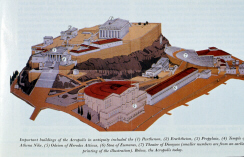 The
primary and primordial performance space in ancient Athens and the home of the
City Dionysia was the Theatre of Dionysus. Built into the slopes of the Acropolis
where it could utilize the natural terrain to create seating, this "instrument
for viewing" is, if not the actual birthplace, certainly the cradle
of Western drama. But its exact structure in the Classical Age is impossible
to determine. It was substantially refurbished twice in antiquity, once in the
later fourth century (300's BCE) and once again in Roman times, making it unlikely
that a single stone visible in the theatre today was there in the Classical
Age. Thus, it is improbable any of the classical tragedians would recognize
much of the theatre we see now other than its location.
The
primary and primordial performance space in ancient Athens and the home of the
City Dionysia was the Theatre of Dionysus. Built into the slopes of the Acropolis
where it could utilize the natural terrain to create seating, this "instrument
for viewing" is, if not the actual birthplace, certainly the cradle
of Western drama. But its exact structure in the Classical Age is impossible
to determine. It was substantially refurbished twice in antiquity, once in the
later fourth century (300's BCE) and once again in Roman times, making it unlikely
that a single stone visible in the theatre today was there in the Classical
Age. Thus, it is improbable any of the classical tragedians would recognize
much of the theatre we see now other than its location.
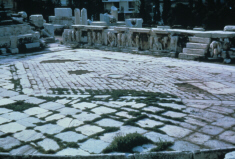
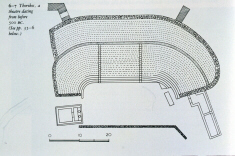 For
instance, the orchestra—"dancing place" (literally,
"instrument for dance")—of the Theatre of Dionysus, the flat
area at the bottom of the theatre where the chorus sang and danced, is
circular today. In the fifth century BCE, however, it was more likely rectangular.
This assertion is based on two, albeit scanty, pieces of information. First,
ancient choral dances were "rectangular," which a rectangular space
would suit better.
For
instance, the orchestra—"dancing place" (literally,
"instrument for dance")—of the Theatre of Dionysus, the flat
area at the bottom of the theatre where the chorus sang and danced, is
circular today. In the fifth century BCE, however, it was more likely rectangular.
This assertion is based on two, albeit scanty, pieces of information. First,
ancient choral dances were "rectangular," which a rectangular space
would suit better.
Second, the only known theatre which has remained unchanged from that day,
the Theatre at Thorikos—Thorikos was an Athenian deme
("district, borough")—has a rectangular orchestra with only
its corners rounded. Nevertheless, it is not certain that the Theatre at Thorikos
was used as a space for performing drama, or just a public meeting ground. In
sum, it is hard to speak definitively about the physical nature of the Theatre
of Dionysus as it existed in the Classical Age, except to say that it was a
large structure capable of housing huge crowds by modern standards.
1. The Skene
Still, it is possible to form at least a few conclusions. For instance, from the very
dawn of Greek drama there was probably a backstage area of some sort, into which
the actors could retire during a show and change costume. There is no ancient
theatre extant that does not preserve or have room for the remains of a "backstage"
of some sort. The Greeks referred to this part of the theatre as the skene
("tent"), recalling, no doubt, its origins as a temporary structure,
perhaps even an actual tent into which the first actors of antiquity withdrew
during performance.
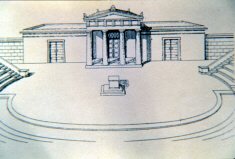 The
situation is not that simple, however. For instance, Aeschylus' earliest plays
(Persae, Suppliants, Seven Against Thebes) were produced
in the Theatre of Dionysus—they are the oldest Greek tragedies preserved
entire—but they do not call for any permanent structure on stage. Thus,
it is not clear that the Theatre of Dionysus prior to the 460's BCE had any
building as such on stage; in that case, the skene could have been
merely a "tent." So, we can be certain that the Theatre of Dionysus
had a permanent skene building only after the first decades
of the Classical Age.
The
situation is not that simple, however. For instance, Aeschylus' earliest plays
(Persae, Suppliants, Seven Against Thebes) were produced
in the Theatre of Dionysus—they are the oldest Greek tragedies preserved
entire—but they do not call for any permanent structure on stage. Thus,
it is not clear that the Theatre of Dionysus prior to the 460's BCE had any
building as such on stage; in that case, the skene could have been
merely a "tent." So, we can be certain that the Theatre of Dionysus
had a permanent skene building only after the first decades
of the Classical Age.
On the other hand, the mask and costume changes that all of Aeschylus' dramas
entail require some sort of structure into which the actors can briefly retire
out of the audience's sight during performance. That Aeschylus' later plays do
indeed call for a skene building with a roof strong enough to hold
an actor standing on top of it, as in the opening scene of Aeschylus' Agamemnon
(the first play of the Oresteia trilogy), shows that by at least 458
BCE there must have been some type of skene building in the Theatre
of Dionysus. However, its architectural style and specific dimensions lie outside
of our understanding at present.
Other dramas preserved from the Classical Age shed a bit more light on the
nature of the skene building in the Classical Age. For instance, they
show that it must have had at least one door, because several fifth-century
tragedies call for actors to enter from a building or for the chorus to pass
from the orchestra into the skene building. Therefore, there was not
only a backstage structure of some sort but relatively easy access between it
and the area where the chorus danced. Furthermore, as noted above, the roof
of the skene building must have been flat and strong enough to support
at least one actor's weight—and two or more by the end of the Classical
Age—so it follows that there had to have been stairs or a ladder inside
the skene leading up to the roof.
But, unfortunately, this is really all we can said with certainty about the
ancient skene. Surviving classical dramas do not refer to it often
or call for its extensive utilization, which argues it was not particularly complex
in its design or application. If true of the Classical Age, the same
may not apply to the post-classical Greek world. By that time, the "tent"
was being used to depict a play's setting through a process the Greeks called
skenographia ("tent-drawing," implying some
sort of painted backdrop) from which comes our word "scene" in the
sense of scenery. So, even if the skene started out as a weak presence
in classical theatre, it grew later, in the fourth century BCE, into an elaborate
structure and, without doubt, represents the beginnings of set design.
C. Special Effects
Other requirements of the theatre called for in classical drama shed further
light on the nature of the Theatre of Dionysus in the fifth century BCE. Several
classical tragedies, for instance, require that the skene building
open up and reveal an interior scene. The Greeks called the device used to produce this effect the ekkyklema ("roll-out"), presumably
a wheeled platform on which an interior scene could be set and then "rolled
out" from the skene building through the main door into the audience's
view. Because Aeschylus' Agamemnon (458 BCE) appears to call for such
a revelation, the ekkyklema probably came into use during the first
half of the fifth century BCE, which makes it one of the earliest special effects
on record.
Yet other classical plays call for an even more spectacular
effect, for actors to "fly" into the theatre. Ancient sources report
that this was done using a device called the mechane
("machine"), a crane which could lift actors over the skene
building and suspend them up in the air by a rope. But the history of the mechane
is more problematical than that of the ekkyklema and raises several
important questions which are unfortunately unanswerable. When was the mechane
first used? How did the actor suspended in the air keep from twisting around
on the rope? Was the mechane's arm (the crane itself) hidden when it
was not in use, or did the ancients even care if it was kept out of general
sight? In either case, where was it placed? Finally, how was it weighted so
that it was manageable? There are no clear answers to any of these questions,
though we can make some educated guesses.
First, the mechane was probably introduced fairly late in the Classical
Age, since no extant play dating before the late 420's BCE absolutely requires
it. The late 430's BCE would be a safe guess. Second, there are simple
ways to keep an actor from spinning around on the rope—for instance, by
tying another rope to his back—but this is pure speculation. The last
two questions—could the audience see the mechane when it was
not in use? and how did the crew manage it?—are crucial because they pertain
to another issue central in theatre history: how illusionistic was the classical
Greek theatre? That is, did the Athenian audience see the action on stage as
realistic, or was it to them a stylized presentation whose art and merit were
not bound up in how natural and real-looking the dramatic vision appeared? There
are no immediate or easy answers to these questions, but if we had greater knowledge
of the mechane, it would certainly help to illuminate this and other
fundamental issues about the evolution of ancient drama.
D. What Greek Tragedy Looked Like:
The Finale of Euripides' Orestes
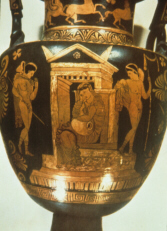 What
is more certain and what we can see for ourselves is how classical dramas call for the use of the mechane and other devices, as well as the Theater of Dionysus
as a whole. These works, at least, give our speculations a guiding framework
and become a laboratory of sorts for our reconstructions. A good example is
Euripides' tragedy entitled Orestes, his most frequently revived play
in post-classical antiquity—so we are told in the ancient notes appended
to this play—and a case study in extreme behaviors, psychotic personalities
and theatrical brilliance. The finale of this tragedy shows how a master playwright in the Classical Age utilized the stage tools at his disposal to create a gripping, panoramic
crescendo of action in the classical theatre.
What
is more certain and what we can see for ourselves is how classical dramas call for the use of the mechane and other devices, as well as the Theater of Dionysus
as a whole. These works, at least, give our speculations a guiding framework
and become a laboratory of sorts for our reconstructions. A good example is
Euripides' tragedy entitled Orestes, his most frequently revived play
in post-classical antiquity—so we are told in the ancient notes appended
to this play—and a case study in extreme behaviors, psychotic personalities
and theatrical brilliance. The finale of this tragedy shows how a master playwright in the Classical Age utilized the stage tools at his disposal to create a gripping, panoramic
crescendo of action in the classical theatre.
The play deals with the aftermath of Orestes' murder of his
mother Clytemnestra, a famous saga in Greek myth. In the course
of Euripides' play, Orestes is driven to despair because no one will help defend
him, including the god Apollo who had originally ordered the young man to commit
matricide, or so Orestes claims. When even his uncle Menelaus refuses assistance,
Orestes at last goes insane, seizes Menelaus' wife, the beautiful Helen who
had caused the Trojan War, and kills her—or seems to, because the report
of her death is inconclusive—and then, to ensure his own safety, Orestes
kidnaps Menelaus' daughter Hermione, his own cousin, and holds her hostage. [Click
here for a fuller explication of this play.]
 The
end of the play is a study in the possibilities for producing spectacle in the
Theatre of Dionysus. Euripides gradually fills the stage with characters one
level at a time, literally from bottom to top. Eventually every possible acting
space and many of the resources at a dramatist's disposal in that day
comes into play.
The
end of the play is a study in the possibilities for producing spectacle in the
Theatre of Dionysus. Euripides gradually fills the stage with characters one
level at a time, literally from bottom to top. Eventually every possible acting
space and many of the resources at a dramatist's disposal in that day
comes into play.
The finale begins with the chorus alone on stage, singing and dancing in the
orchestra at the bottom of the theatre. Next, Menelaus enters with his army,
a secondary silent chorus. He—and they, too, presumably—stand on
the main level of the stage before the door of the skene building.
He demands that Orestes open the gates of the palace, but Orestes appears instead
on its roof with several other characters: his sister Electra, his friend Pylades
and Menelaus' daughter Hermione whom Orestes threatens to kill if her father
tries to force his way into the palace. They quarrel and Menelaus gives the
signal to attack. In response, Orestes orders his friends to torch the palace
and kill Hermione.
Primordial chaos seems ready for its climactic close-up, when in flies the
god Apollo on the mechane, soaring above the din and smoke. This solar
deity—the divine personification of light, reason and, in this case, "better
late than never"—does not, however, hover over Argos alone but has
the not-dead-yet Helen, flying beside him in first class. He had just recently
rescued her from Orestes' assault and turned her into a goddess so she can live
with him.
The Greek stage is now packed as full as can be, with speaking characters on
every level, in order from bottom to top: the chorus in the orchestra, Menelaus
and his troops at the door of the skene, Orestes and his gang of kidnappers
above them on the roof of the skene, and the gods, both new and old,
swinging on the mechane over all of it. It is a very craftily orchestrated
and deliberate sequence of action designed to lead to a visually stunning spectacle
of pessimistic, or at least ironic, grandeur! And, if one counts the sun—which
it is a safe guess was shining that day, or any day when there were plays being
presented at the City Dionysia—there are, in fact, five levels of action,
with the "star of stars," Apollo's ensign, beaming down impassively
on all of this feeble human madness. [We will return to this tragedy later.
It is too theatrical and well-written to pass without a second glance.]
III. Actors and Acting in Ancient Greece
Thus, Euripides' Orestes ends with what must be one of the most breath-taking
scenes in all of Greek theatre, employing nearly every resource the Theatre of Dionysus
in the Classical Age had to offer. It is hard to imagine a tragedian
of this era calling for much else. Still, hard as it may be to believe,
Euripides has more up his sleeve than this tragedic traffic-jam. To understand
what that is, one must take into account the full dynamics of Greek performance.
What modern audiences overlook, though ancient audiences would not have, is
that there is one speaking character, or set of characters, on each level of
the stage, from top to bottom: Apollo (mechane), Orestes (roof of the
skene), Menelaus (stage) and the chorus (orchestra).
A. The Three-Actor Rule
This demonstrates another important facet of the classical Greek theatre.
Besides the chorus, only three actors performed all the speaking roles in tragedies
produced at the Dionysia, although the authorities who oversaw these celebrations
of Dionysus allowed on stage any number of mute actors. These non-speaking parts
were probably played by young actors-in-training whose voices were not as yet
fully matured and could not project well enough to be heard throughout the enormous
arenas encompassed by classical theatres.
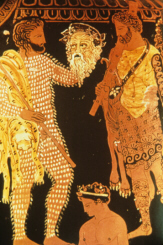 But
all known tragedies include more than three speaking characters, which means
actors must have performed more than one role in the course of a single play. While on the modern stage
multiple-role-playing may sometimes entail difficulties—audiences
today who sit relatively close to the stage will naturally expect a high level
of realism which may be all but impossible for the actor playing more than one
role to effect—the same was not true in ancient Greece. Role-changing
was eminently practicable on the Athenian stage, not only because the majority
of the viewers sat some distance from the stage but, more important, because
the actors wore masks and costumes facilitating their ability to play different
parts. That is to say, within the scope of a single tragedy, an actor might
portray as many as five different characters, sometimes very different
ones, with relative ease since altering his façade through a change of
mask and costume was a traditional element in Greek theatre.
But
all known tragedies include more than three speaking characters, which means
actors must have performed more than one role in the course of a single play. While on the modern stage
multiple-role-playing may sometimes entail difficulties—audiences
today who sit relatively close to the stage will naturally expect a high level
of realism which may be all but impossible for the actor playing more than one
role to effect—the same was not true in ancient Greece. Role-changing
was eminently practicable on the Athenian stage, not only because the majority
of the viewers sat some distance from the stage but, more important, because
the actors wore masks and costumes facilitating their ability to play different
parts. That is to say, within the scope of a single tragedy, an actor might
portray as many as five different characters, sometimes very different
ones, with relative ease since altering his façade through a change of
mask and costume was a traditional element in Greek theatre.
Indeed, extant dramas prove that the ancient Greek actor
was expected to be able to impersonate the full range of humanity—from young
girls to old men—by adapting his voice and mannerisms, much as is still done
in various types of Asian theatre. And, as in some performance genres found
there, men played all parts, male and female (note).
As a result, the art of ancient acting centered around a performer's flexibility
carried out with the help of the masks and costumes which hid his own face
and form from the audience's view.
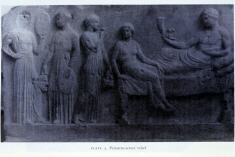 Furthermore,
it is clear that no more than three actors portrayed all the roles in any classical drama,
a tendency today called the "three-actor rule." That
this was, in fact, a restriction scrupulously enforced at the Dionysia is also
certain, and not just because later historical sources like Aristotle and Horace allude
to it, but because the surviving dramas of this period show this rule in action.
In other words, the plays constitute primary evidence that three actors at most performed all the speaking roles in classical
tragedy and satyr plays, for the simple reason that all such drama—even
the surviving fragments—require no more than three speaking characters
on stage at once.
Furthermore,
it is clear that no more than three actors portrayed all the roles in any classical drama,
a tendency today called the "three-actor rule." That
this was, in fact, a restriction scrupulously enforced at the Dionysia is also
certain, and not just because later historical sources like Aristotle and Horace allude
to it, but because the surviving dramas of this period show this rule in action.
In other words, the plays constitute primary evidence that three actors at most performed all the speaking roles in classical
tragedy and satyr plays, for the simple reason that all such drama—even
the surviving fragments—require no more than three speaking characters
on stage at once.
In addition, two other features of classical drama make it clear that there
were only three actors playing all the roles. First, no extant tragedy staged
before the end of the Peloponnesian War requires actors to share a part. That
is, ancient Greek playwrights disposed the action in their dramas in such a way that
the characters assigned to any particular actor never converse on stage. In other words, if one actor takes on the roles of both Electra and Menelaus, those particular characters
never appear on stage and speak together during the course of that play. Second, ancient Greek tragedians
invariably give actors a certain period of time, usually the interval
covered by about fifty lines of dialogue, to make mask and costume changes.
That comfort margin, so to speak, along with the other aspects of Greek tragedy
mentioned above, seal the case for the "three-actor rule."
Less clear is why there were only three actors. Presumably, having performers
play more than one role was a traditional component of the Greek theatre, perhaps
from the very inception of Greek drama when there was only one actor and a chorus.
Thus, ancient audiences, no doubt, expected a certain amount of multiple-role-playing
in a drama. Comparisons to Homer who gave voice to all his characters would certainly have prepared Greek theatre audiences for actors performing multiple roles.
But the reason the evolution in the number of actors stopped at
three is a question for which there will probably never be a fully satisfactory
answer, nor must there be only a single reason for this rule. One credible explanation
which almost assuredly had some force in the creation and maintenance of this
restriction involves the religious element in ancient theatre, whose conservatism
surely resisted change on all fronts including adding more and more actors to
the stage. Equally compelling is, no doubt, the jealousy of premier performers
in competition with one another for a prestigious honor at the Dionysia during
the latter half of the Classical Age. This must also have encouraged holding
the numbers of speaking performers down. Envy among rival actors is one of the
few reliable constants in the world of entertainment.
B. Voices on Stage: Dialogue and Trialogue
Whatever the reason, the three-actor rule is
visible at work in the tragedies of all three playwrights, even the earliest,
Aeschylus. Although he rarely has all three speaking actors on stage at once,
he does so often enough—in his later tragedies, at least—that it
is likely he regularly had three actors at his disposal, or two if he himself
is counted as one of the performers (note).
It is interesting to note, then, that his characters never engage in a trialogue—that
is, three actors conversing in the same scene, even when there are three on stage. So, for instance, during the confrontation between Agamemnon
and Clytemnestra in Aeschylus' Agamemnon, the actors portraying these
two characters speak to each other. Though another actor is on stage dressed
as Cassandra (Agamemnon's Trojan concubine and prisoner-of-war), that actor
says not a word during this scene. Rather, he remains on stage silent for a
long time and only finally speaks two scenes later. Thus, during the scene in which Agamemnon and Clytemnestra converse, Aeschylus does, in fact, bring out three speaking actors together on stage, even if they do not all join in the
same conversation or engage in a trialogue.
Why doesn't Aeschylus have all three actors speak together in that
or any scene? Close examination of the nature of Attic theatre and the ramifications
of its conventions pertaining to performance provides several good reasons for
this. First and foremost, it is important to remember drama was a new art form
in Aeschylus' day. It had most likely grown from a one-man show with a chorus
as back-up—in the earliest recorded stages of tragedy, there is no mention
of actors, only a playwright and a chorus, which supports the notion that
playwrights originally performed all the speaking character parts—then it evolved to a
two-performer and later a three-performer arena. From our perspective, this transition
seems simple, but in the day a play with so many actors on stage at the same
time must have looked like a three-ring circus, especially to an audience accustomed
to having only one "voice" present all the characters in a story,
the way Homer and other epic poets did.
As a result, a conservative approach to dialogue is visible in Aeschylus' plays
where, any time two characters have a dialogue, the situation is always carefully
managed. For instance, the action leading up to a dialogue in an Aeschylean
drama tends to proceed in the following manner: each of the speaking characters
is brought in separately, they deliver discrete monologues (often punctuated
by choral interjections), and only after some time do they at last exchange
words back and forth. This cautious approach, as the playwright makes sure that
the audience has heard both the actors' voices and understands the two characters'
distinct points of view, confirms that in the early Classical Age the audience
required some preparation before a conversation could take place on stage.
Historically, this makes sense as well. If we can believe Aristotle who claims
the second actor was the invention of Aeschylus, dialogue of this sort did not
exist until the 490's BCE at the earliest. Seen that way, playwrights in the
earliest phases of Greek drama would have resembled the epic poets who dominated
public performance in the Pre-Classical Age, except that these playwright-bards
had a chorus behind them and dressed to fit the roles they were impersonating
instead of merely narrating what happened or was said. Epic poets, after all,
could not have performed dialogue the way it was done in tragedy since only
one of them performed at a time. Nor could playwrights in the earliest phase
of tragedy, until the day Aeschylus introduced the second performer and the
first actor-to-actor dialogue.
Yet to have the capability of doing something in the theatre is one thing and
to carry it off on stage is another. The audience must be able to follow what
transpires on the stage and enjoy it, or what is the point? The glaring realism
of a stage dialogue surely appeared quite startling to Aeschylus' audience,
accustomed as they were to a solo poet supplying all the individual characters'
voices in a performance. To have a pair of men doing this would have looked
to an ancient audience like there were two epic poets performing at once, a
wonderful notion but also a situation fraught with the possibility of confusing
audience members about what exactly was unfolding before their eyes. That explains
why Aeschylus is invariably circumspect in approaching dialogue. He must be
careful not to lose his audience in the course of the performance
by having two characters, for instance, walk on stage speaking in rapid exchange, something
which would almost certainly have over-taxed his audience's ability to follow
what was being said on stage and by whom.
Another aspect of tragic discourse supports the view that the spectators of
early Greek theatre needed help in following any discourse significantly more
complex than a simple exchange of speeches. As poetry, the rhythms of dialogue
in tragedy were somewhat predictable to the audience, especially if changes
of speaker occurred at breaks in the poetic meter, the way, in fact, they regularly
do in classical tragedy. That is, typically one character speaks a single full
line of meter, and the other says the next and then the first another and so
on, in a type of interchange called stichomythy (in Greek,
stichomythia, "line-talking"). This clear and predictable
pattern of exchanges of dialogue line by line helped the ancient audience understand
which character was talking at any given moment, because they knew in advance
when one character would stop speaking and the next character would begin.
Stichomythy is also a natural product of the venue in which it played. The
size of the theatres in which Greek dramas were presented put most spectators
some distance from the action—add to that the fact that the actors were
wearing masks so that, even if seated close to the stage, viewers could not
see the performers' lips moving—thus it's easy to understand the need
for such a stylized conversation device as stichomythy. Careful preparation
before a dialogue and a predictable exchange of words would have greatly improved
the audience's ability to follow a conversation on stage, especially when presented
with masked actors who were playing in an immense arena. Given all that, most
spectators would have benefited greatly from any help determining which character
was talking at each particular moment.
And then, to have yet a third speaker enter the conversation would,
no doubt, make the situation all but hopelessly hard to follow, certainly for
an audience as new to drama as Aeschylus'. It says something for their heirs
that only a generation later Sophocles' viewers were apparently able to follow
a trialogue. That, however, may have had as much to do with the growing talents
of the performers who helped the audience grasp which character was speaking as with the ancient Greek audience's increasing sophistication in following theatrical conventions. Actors
with distinctive voices would also have facilitated the process greatly. Moreover, the growing general interest in theatre surely also stimulated
both actors and their public to look for ways of overcoming these obstacles.
Playwrights, too, may not have entirely deplored the
limits imposed on them by this situation. Aeschylus' plays, for instance, show
more than just a mastery of this technical aspect of his medium. Clearly he
also had fun in the process of creating drama which used a restricted number
of actors. Close examination of his plays suggests he may even have liked
it. Indeed, in the aforementioned sequence of scenes that include the
confrontation between Agamemnon and Clytemnestra in Agamemnon, it appears
that Aeschylus is playing with his audience's expectations about how many speaking
actors are on stage, indeed taunting them with the very possibility of a third
speaking actor, which was almost certainly a novelty in that day.
In particular, he toys with his audience as to whether or not Cassandra will
speak. At first, in the Agamemnon-Clytemnestra confrontation, her first appearance
on stage, Cassandra does not say a word. Nor does she again in the next scene,
when Clytemnestra attempts to speak with her one on one. Although Cassandra's
silence is well-motivated by the plot—she is a prophetess and sees what
is going to happen, that Clytemnestra is about to kill both her and Agamemnon—her
muteness plays on another level also. What Aeschylus appears to be doing, as
Cassandra refuses to speak first in one scene and then again in the next, is
baiting the audience into supposing that Cassandra is not being played by a
speaking actor but only a mute player. After such a prolonged silence and her pointed
refusal to converse with Clytemnestra, many of those in Aeschylus' audience
would, no doubt, have arrived at the conclusion she will never speak in this
play because the role is not being played by a speaking actor.
But then just as this appears to be the case, Aeschylus has her at long last
break into speech—actually song!—followed by an extended and moving
scene on stage between her and the chorus. It is tempting to suppose some great
actor-singer of the day has been hiding behind the mask and costume of Cassandra
so that this character's long-delayed eruption into song is Aeschylus' ploy
with which to surprise and dazzle the crowd.
This goes some way toward explaining the meaning of the verbless sentence in
Aristotle's Poetics (4) that Sophocles,
not Aeschylus, introduced the "third" actor to tragedy. If we assume,
as noted above, that in glancing over Aeschylus'
plays Aristotle saw that there were no overt trialogues and from that concluded
Aeschylus did not use three actors, then it is easy to surmise he has failed
to envision fully the action of Aeschylus' drama theatrically and has overlooked
the presence of temporarily silent "speaking actors," a very different
thing from true "mute actors" who portray characters that never speak
on stage.
A detail found in an ancient biography of Sophocles
may further corroborate the assertion that Aristotle has failed to assess the
data correctly. Though replete with spurious assertions, this purported account
of the great tragedian's life includes what seems to be at least one detail
validated from other quarters. It suggests that the great tragedian did not
act in his own plays because he suffered from microphonia
("small-voicedness"). Other sources, both documentary and artistic,
support this general idea. For instance, Aristotle tells us that, when Sophocles
acted in his own plays, he played only minor roles such as a lyre player, which
makes sense if the playwright lacked a voice powerful enough to perform the
great and demanding roles written for the Greek stage. In further support of
Aristotle's assertion, we are also told that a famous painting in antiquity
showed Sophocles playing the lyre. With such corroborating evidence there is
some basis, then, for believing the biographical record is accurate about his
microphonia. If so, it becomes easier to understand why Aristotle might
credit Sophocles with introducing a third actor to the Greek stage, since in
those days a man with a weak actor's voice—though it is hard to imagine
anyone having a stronger playwright's voice!—would have to do
something to compensate for such a fundamental deficiency.
So, if by "third actor" Aristotle means "third non-playwright
performer," then his words can be seen as technically correct. Indeed Sophocles,
because of his microphonia, may have been the first to bring a third speaking actor on the stage—that is, three actors as opposed to two actors and a performing playwright—but that does not mean he inaugurated the tradition of having
three speaking characters on stage at the same time. That, in fact,
was more likely Aeschylus' invention. Seen this way, the dramatic evidence can be brought
into line with Aristotle's statement which is now valid, if needlessly terse
and uncharacteristically confusing.
But there's more to Sophocles' situation than counting
actors. In surrendering the stage entirely to "actors," i.e. men who
performed words others had written, he became the earliest known "modern"
playwright, in the sense that he is the first dramatist we know of who watched
his own plays from the theatron. This, in turn, goes some way toward
explaining another feature of his drama, his eye for creating complex, multi-layered
action on stage where silent or minor characters play important roles. This
is surely the product of his being a scriptwriter who sat with the audience
taking in the show like any other ticket-holder. In other words, in imagining a play
he watched it the way a spectator would, not from inside a mask as Aeschylus
and all his predecessors had. So, if not an innovator in the actors' arena,
Sophocles deserves credit for seeing drama from the audience's vantage point
to which the compelling complexity of his stage action attests, where irony
and characters in the background often comment on what's happening front and
center, and sometimes can even upstage it.
By the middle of the fifth century, actors had been installed as a fixture in the Athenian
theatre scene. At some point in the 440's BCE, they even started receiving their own awards
at the Dionysia, a clear recognition of their growing role in the burgeoning artform. That
this began shortly after Sophocles separated playwriting and acting should come
as no surprise. No longer the subordinates of a playwright who hired them so
he could have a dialogue partner, actors were now their own independent
artists, much as they are today, and without the playwright to outshine them
on stage their prestige ballooned. Indeed, by the fourth century the best-known
names in theatre, stars like Polos and Neoptolemos, belonged not to playwrights
but actors.
Around that time, the theatre which has never been without its caste systems also evolved a hierarchy of performers. Later—perhaps much later since
we do not know the date—separate words were coined referring to the three
different actors: protagonist, deuteragonist
and tritagonist, meaning respectively "first competitor,"
"second competitor" and "third competitor." In post-classical
Greece, these terms came to carry connotations of quality, too. So, for instance,
tritagonist could also imply "third-rate." But it is not clear if any of
this was true in the Classical Age. Even so, we know that the discrimination
among these performers goes back well into the fifth century BCE because, from the very first when actors were given prizes at the Dionysia, only the principal
actor got an award, not his co-performers.
Finally, this attests to something else very important about the evolution
of acting in the classical theatre. The fifth-century audience must have been
able to distinguish different actors on stage even when those performers were
hidden behind a mask and costume on stage. In order to be able to recognize the work of an individual
actor—and only him, not his colleagues!—the ancient public had
to have had the ability to recognize him and follow him through his changes of role during a performance. Furthermore,
some classical actors were famous and well-known by name. If audiences could
not distinguish them as they played a series of roles on stage, how could they
come to respect and admire them? It could not have been by face or figure, the
way modern actors are most often recognized, because an ancient actor's features
were not visible on stage. Instead, the voice must have been the actor's principal
tool, an absolute necessity in his artistic arsenal. So it must have been through
their distinctive and powerful voices that Greek actors made their mark on the
world, more like today's opera singers than movie stars.
C. Producers and Sponsorship
Last but not least, the organization and sponsorship of the Dionysia and the
Lenaea, the principal dramatic festivals in Athens, evolved drastically over
time. While it is hard to keep track of all the changes that took place in just
the first two centuries of institutional theatre at this venue, there are some
constants. Until the Hellenistic period (ca. 300 BCE), playwrights and their
casts were sponsored by a producer of sorts, called a choregos
(plural choregoi), literally "the chorus leader,"
who underwrote the funding that allowed a play to reach the stage. Usually a
rich man who was required by law to perform some kind of public service, the
choregos was a producer of sorts who took on the duty of housing
and feeding the chorus for the entire duration of rehearsal and production.
He also bought the costumes, props, set pieces and anything else deemed necessary
for the show. That could be a very expensive endeavor, but it could also reflect
well on his civic-mindedness and sense of duty to the state.
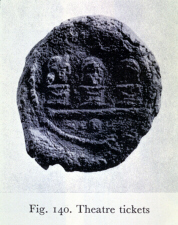 Moreover,
even from the earliest days of the Dionysia a winning choregos' name
was recorded on stone memorials set up in public places, which made the expense
of production a potentially good advertising investment. Quite a few of these
"angels" over time put on lavish spectacles and won widespread acclaim
for doing so, with which came other advantages. For example, if he fell later
into some sort of legal trouble and was taken to court, a former choregos
could remind the jury, composed largely of men who had seen "his"
show, that he had once hosted a great entertainment for the state. To judge
from how often such things are mentioned in the records of ancient Greek lawsuits, the argument must have had some force.
Moreover,
even from the earliest days of the Dionysia a winning choregos' name
was recorded on stone memorials set up in public places, which made the expense
of production a potentially good advertising investment. Quite a few of these
"angels" over time put on lavish spectacles and won widespread acclaim
for doing so, with which came other advantages. For example, if he fell later
into some sort of legal trouble and was taken to court, a former choregos
could remind the jury, composed largely of men who had seen "his"
show, that he had once hosted a great entertainment for the state. To judge
from how often such things are mentioned in the records of ancient Greek lawsuits, the argument must have had some force.
The exact nature of the selection process by which playwrights and choregoi
were brought together is not clear. Nor are any of the administrative procedures
surrounding the City Dionysia, including many things we would like to know,
such as the exact methods used in awarding prizes to plays. To make matters
even worse, the means of matching playwright and producer seems to have changed
over time, though certain features of the process stand out throughout the fifth
and fourth centuries. For instance, while the choregos funded the enterprise,
it was the playwright who was in charge of the production for the most part
in the Classical Age. From early on called a chorodidaskalos
("chorus teacher"), the playwright apparently "taught" the
chorus its songs and dances and oversaw the rehearsal process in general, even
if he did not pay for it out of his own pocket.
But by the fourth century BCE, as we noted above, the playwright's role in
drama had diminished greatly and actors had become the principal attraction
in Greek theatre. As such, they began to assert their will over productions.
How the theatre evolved from there is even harder to reconstruct, but in general
it seems safe to say that the material remains of ancient theatre and the historical
sources relating to it, as well as the extant dramas themselves, show a living,
evolving art form which, maddening as it is to pin down, was a vibrant and vital
part of the ancient Greeks' world: an echo of their heartstrings, a mirror of
their souls and a banquet for their minds..
Terms, Places, People and Things to Know
|
City Dionysia
Trilogies
Satyr Play [SAY-turr]
Lenaea [luh-NIGH-uh]
Theatra (Theatron) [THAY-ah-trah; THAY-ah-trahn]
Voice
Theatre of Dionysus
Courtroom Trials
Interiority
Presentationalism
Acropolis
Orchestra
Theatre at Thorikos [THORE-rick-koss]
Skene [SKAY-nay]
Skenographia [SKAY-know-graff-FEE-uh]
|
Ekkyklema [eh-KOOK-clay-mah]
Mechane [MAY-kahn-nay]
Orestes [oar-REST-tease]
Orestes
Clytemnestra [KLIGH-tem-NESS-trah]
Multiple-Role-Playing
Three-Actor Rule
Trialogue
Stichomythy [stick-KOMM-muth-ee]
Microphonia [mee-crow-phone-NEE-ah]
Protagonist
Deuteragonist
Tritagonist
Choregos (Choregoi) [core-RAY-goss; core-RAY-goy]
Chorodidaskalos [core-oh-did-DASS-call-loss] |
This work is licensed under a Creative Commons Attribution-NonCommercial-ShareAlike 4.0 International License.
 Three
tragedians emerge from the fifth century BCE as the principal practitioners
of classical Greek tragic drama: Aeschylus, Sophocles, and Euripides. Theirs
are the only tragedies preserved whole. First and foremost, Aeschylus lived
a generation earlier than the other two so his work provides our first hard
look at Greek drama. Even if his plays may seem static and slow-moving to modern viewers, there can be little doubt they were exciting, novel and controversial in their day.
Three
tragedians emerge from the fifth century BCE as the principal practitioners
of classical Greek tragic drama: Aeschylus, Sophocles, and Euripides. Theirs
are the only tragedies preserved whole. First and foremost, Aeschylus lived
a generation earlier than the other two so his work provides our first hard
look at Greek drama. Even if his plays may seem static and slow-moving to modern viewers, there can be little doubt they were exciting, novel and controversial in their day.














